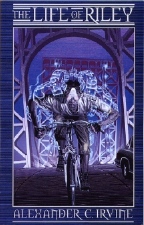 |
 Alexander C. Irvine
Alexander C. Irvine
The Life of Riley
Reviewed by: Rick Kleffel © 2005
Subterranean Press
US Hardcover First Edition
ISBN 1-596-06013-1
Publication Date: 09-26-2005
140 Pages; $25.00
Date Reviewed: 04-14-05
Index:
Science Fiction
Mystery
All we know is all we're told. The how and the who of the telling are up to the author. What we make of the narrative, the world we create in our minds as and after we read the book, that world is sculpted from the words we're given. More -- or less. That's the author's call. Alex Irvine makes a most unusual call in 'The Life of Riley'. He's created an incredibly complex, textured world, a mysterious plot and huge cast of characters with four brief brushstrokes. I've often remarked on the similarity between mystery and science fiction, and how, in science fiction novels, the mystery is often best expressed as: What is this world? How is it like ours, and unlike ours? How did our world become this world, or did it?
'The Life of Riley' is a science fiction mystery that takes a very unique format. Set some thirty years in the future, it's the story of Gabriel Riley. And instead of following the story simply from beginning to end, 'Maltese Falcon'-style, we see the same story from four different vantage points, 'Rashomon'-style. It makes for dense, intense and intricate reading. Even though the novel is only 140 pages long, there's more story, more plot and more character here than in many a four-hundred-page-plus book-brick. Reading the novel is like viewing each of the layers of a four-color separation individually, and then putting the layers on top of one another to get the full color picture. It's bracing, brainy, and occasionally frustrating. But the moment of revelation when the last word of the last layer unfolds offers an unparalleled reading pleasure.
Irvine's future is a crazy-quilt patchwork of cluttered anarchy. Fundamentalist Christian religious groups have overrun the country, as well as some very humanoid aliens that humans call Bettys. The climate is a catastrophe, and poverty is the default. Everything is a big old mess. Gabriel Riley is part of the guard service protecting a tent city of refugees camped on the White House lawn. Did he shoot the protestor? Why would the Bettys be involved? Better question: why are they here? Christian undergrounds, alien splinter factions, hallucinating mystics and apocalyptic consequences clash and counter one another. Is Gabriel Riley the savior of the human race, or is he the key to bring about its downfall?
Irvine lets his story unfold from the vantage point of Riley's wife, Zena, a Betty that calls itself The Counselor, a hallucinating Christian mystic named Truman Throckmorton, and Nate Drinkwater, an ordinary guy who finds himself in the middle of an arcane plot. First Zena and the Betty tell their stories in the first person. Irvine follows these passages with Truman's, then Nate's, both told in the third person. He's remarkably successful at creating four very individual and unique voices. Each speaker brings a different understanding of what is happening, and adds to the story that precedes it, even when they contradict one another.
Irvine's world of the future is incredibly entertaining. It’s spiky, familiar and unutterably alien, and not just because aliens have arrived on the earth. The chaos that surrounds us today has seemingly overtaken us. The United States is no longer united. It's a fractured, Balkanized mess. The characters cross paths, but the paths don't converge. The plots intersect one another, but they don't join. Occasionally, this technique succeeds only in frustrating the reader's attempt to understand, but as the book progresses the details begin to create fascinating interference patterns. It's as if by laying one screen on top of another, you could eventually form a picture. Upon finishing the second portion, readers will want to re-read the first and the second. Upon reading the third section, the reader will want to re-read the first three sections, and upon finishing the book, the reader will want to re-read the whole shebang.
Irvine's prose is chameleonic, adapting itself to the teller and the tale. From the stilted voice of the Counselor to the free-flowing visions of Truman Throckmorton, Irvine shifts color and tone effortlessly. And his world is truly a wonder to behold, so bursting with life that readers will be able to visit rooms, sewers and scenes long after they’ve finished the novel.
Whether they'll understand precisely what transpired is another matter entirely. 'The Life of Riley' piles up contradictions, misunderstandings, lies, damn lies and politics into a pixilated vision of our future, and feeling trumps understanding. Irvine embraces the chaos of the present with an unbridled enthusiasm, and he distills it into intoxicating prose liquor. 'The Life of Riley' is intriguing, exciting, and enigmatic. The real mystery here is how a novel so small on the outside can seem so much bigger on the inside. Irvine layers understanding and misunderstanding, lies and truths, the large and the small. Slot them together, one on top of another, and shine your brightest light through the story. Every layer adds color and complicates the picture. And in the end, you know much more than you were told.
|
 |
